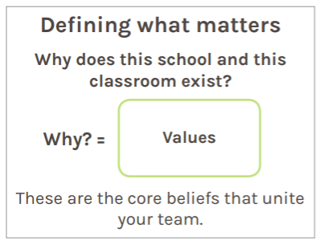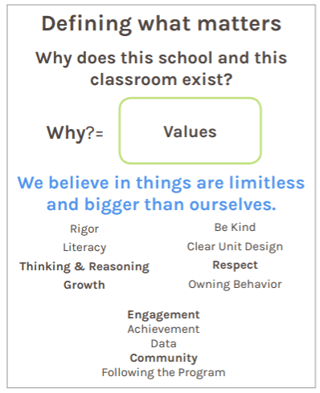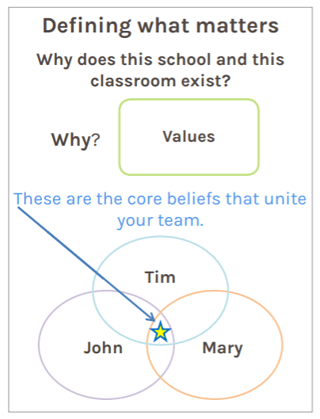 If you haven’t really thought about it, the values teachers might ascribe to their classrooms, their schools or school in general might look like a blank page to you. However, everyone brings their own values and core beliefs to the table.
If you haven’t really thought about it, the values teachers might ascribe to their classrooms, their schools or school in general might look like a blank page to you. However, everyone brings their own values and core beliefs to the table.
Let’s take a step back from the Next Generation Science Standards, which set the stage for the challenges ahead, and talk for a bit about how to manage the change they will require in the context of our teaching teams, our school buildings and even our districts.
First we’ll take a look at the why, and then turn our attention to the what and the how. The focus of this post is, why do teaching and learning matter? Picture yourself with your team, sitting down and asking questions such as:
- Why does our school exist?
- Why does our classroom exist?
- Why does our district exist?
- What are the things that we value?
- What core beliefs do we hold that give us a real purpose in existing here as a team?
These questions can be scaled to different levels, whether it's a school building or an entire district, but to be effective, these questions must take into account the opinions of several people. We’re talking at least five, and up to as many as 150 people who get a voice in these discussions.
Because the truth is, buildings set values.
It’s not individual people or individual classrooms, but whole buildings and even collections of buildings (districts) that inform the values that emerge.
When you sit down with your team and really take a look at what matters, you’ll likely get multiple answers back in return.
Values like rigor, literacy, growth, thinking and reasoning are all typical values that teachers may hold and often define their reasons for teaching in the first place. If we can find common ground among those values, beliefs an entire team strives to uphold, that’s major headway toward understanding and leveraging how an educational system operates.
However, the strongest producers of values are individual buildings or schools because the teachers working together there typically forge a unified purpose and unified core beliefs. Those teams are what really define the culture and the climate of that building. That's why you can look out over a district and find buildings with very different climates and cultures.
Between these buildings, you will also see very different results on a number of levels, including engagement of teachers and administrators, parents and children. These values are huge. When you sit down with your team and ask about their values, you will likely get responses such as “rigor” and “literacy,” but the truth is, these values aren’t as important as some others. The values that really tie teams together, that pave the way for excellent learning and environments, are the values that are bigger than us as individuals.
 This is where it gets very real. It is important that the values we agree on as paramount are beliefs that are, in a sense, limitless. They must be bigger than ourselves, so big that we can't achieve them on our own. We don’t use the expression “bigger than ourselves” merely in an academic or cliché sense, but very intentionally.
This is where it gets very real. It is important that the values we agree on as paramount are beliefs that are, in a sense, limitless. They must be bigger than ourselves, so big that we can't achieve them on our own. We don’t use the expression “bigger than ourselves” merely in an academic or cliché sense, but very intentionally.
The important values, in terms of unifying a team and keeping focus and buy-in intact, are the ones that require multiple people to achieve. These are ideas that we value so much we realize we need one another to achieve them, and it’s worth it.
These beliefs must be part of the continuum of values that give meaning to our classrooms and schools, to the very purpose that brought us into the field of education in the first place: to develop the thinking and reasoning of our students, to help students hone their higher order thinking skills, and to mold creative, analytical and evaluative thinkers.
Just What Is a "Value"?
Before we can get to the root of such lofty purposes, however, we must understand what values themselves are, so let’s spend a moment talking about that.
A value is a big idea.
Think of the Declaration of Independence, the US Constitution, or the Bill of Rights. These documents are full of big ideas that unite Americans as a people. (Our apologies to readers who are not from the United States, but please bear with the example and try to see it in the light of your own country’s values.)
One of the most cherished American values is freedom, which can take many forms: Freedom of expression Life, liberty and the pursuit of happiness … and so on. These ideas unite us on paper, but they really come to life in our hearts. If you were to meet somebody anywhere else in the world, and that person were American, you would most likely share at least some of these core values.
These ideas, interestingly, not only define how we think of freedom, but also inform the ways we organize ourselves, our modes of justice, the way that due process occurs in our country, and our ideas of how we treat one another. They also trickle down to more mundane but still central ideas such as what constitutes acceptable business and safety practices. Our values inform the ways justice is carried out, what an acceptable punishment looks like, what we do and do not support occurring in our legal system, and so on.
Our values, in other words, are everywhere, and it is the values we share that dictate what everyday life looks like.
We can also see these values reflected in the debates we have every day, in politics, on the news and in our free time. In our schools, it's the same thing. As we see this shift in Next Generation Science Standards, we’re going to see a shift in how people begin to have these conversations surrounding STEM principles and instruction. We will doubtless see a lot of gear-grinding, but by being aware of these pieces, we can heighten our awareness of what's coming and lessen the sense of anxiety that we’re entirely in the dark.
Keep in mind that these are not one-and-done values. We can’t just check a box and call it good. No, these values must have infinite potential and be bigger than ourselves. They must be as meaningful in third grade as they are in tenth grade. We only get one year with our students, but by banding together with our teams and in our buildings, suddenly we form continuous values that extend from pre-k all the way through grade twelve. This nurturing process prepares students for something that is itself limitless: their future.
That's really a key in maintaining focus and buy-in: helping teams convene with discussions around educational values and identifying those values that really bring everyone together. We will talk later on the blog about what those methods are, but for now let’s discuss what it is we actually do in our day-to-day educational environments, and what that means for uniting us as teams.
What We "Do"
When it comes right down to it, these values speak directly not only to what our purpose is in education but actually to what we do. The values bolded in the image above stand out because they are the ideas and goals that truly are limitless. This isn’t just something we wrote down ourselves, either. We actually put this question to dozens of educators and got a multitude of values back in response.
But these are the ones that came back as most important. Think about it. Rigor is not really something bigger then ourselves; it’s not limitless, but rather a finite educational idea. Literacy is not limitless or bigger then ourselves either. However, these ideas are part of other limitless values. For instance, rigor is part of growth. Literacy may be part of thinking and reasoning, or it may be part of engagement, but thinking and reasoning hit the highest level a value can attain, and these other, smaller values sort of cascade from them.
The idea is fairly simple: We all have a wealth of values, but the ones we most commonly share tend to be the highest level values, and contain within them smaller values (such as rigor, literacy).
 Values are the core beliefs that unite people as a team. If you identify and bring forth the right values in your curriculum, you have a much greater chance of leading without losing the focus or buy-in you need to make curriculum successful. If you fail to identify these core beliefs, your chances aren’t as good.
Values are the core beliefs that unite people as a team. If you identify and bring forth the right values in your curriculum, you have a much greater chance of leading without losing the focus or buy-in you need to make curriculum successful. If you fail to identify these core beliefs, your chances aren’t as good.
Let’s take an example. Picture three team members: Tim, John and Mary. They're each going to value smaller things as well as really big things, but only a few values are going to be in common. It's those values, the beliefs we have in common, which become the values of our schools and our districts, and eventually get carried into our classrooms.
The role of values here is to unite all of us in our building and our district around things that we believe at our core. Core beliefs are, in a sense, things we would fight for. It is those values that will unite us and will help you as a leader maintain the focus and buy-in of your team during tough transitions.
Our values are the reasons why we teach and why we're committed to the discipline. From that flows what we actually do during the day. In other words, our values contribute to the mode of instruction we use, and that mode of instruction must reflect our values if we are going to do a good job, be successful and take pride in our work.
Notice we’re using the words our values. Using the image above, we have moved past a collection of three mere individuals, John, Tim and Mary. By focusing on that overlap between them, we have formed a team. Keep in mind that we could add many more people to this image, all of them overlapping in that area of core beliefs, and everyone in the picture would still be tied together by those same values.
However, this begins to pose a problem as size increases. The larger a district gets the harder it is to get people to coalesce around a set of overlapping values. Fortunately, there tends to be a lot overlap for teachers because of the nature of the profession. However, the problem remains that more than a certain number of teachers makes value agreement difficult. This is a main reason why climate and culture tend to emerge at a building level.
In other words, because our shared values shape the choices we make in teaching and learning (what to do and what not to do), culture tends to emerge at the building level, and therefore success is frequently determined by values at the building level.
Nevertheless, those values that unite all of us, in terms of the mode of instruction that we consider acceptable and what motivates us to go to work in the morning, are crucially important because they are ours. If we recognize them as such, we can become a self-aware group that begins to approach instruction in terms of what we are willing to entertain or not entertain in light of our values.
That's really important; after all, if something doesn't align to your values, why are you doing it?
Whether or not something aligns to your values will be critical in terms of whether you buy in; similarly, whether or not something aligns to your team’s values is critical to whether or not they buy in. Therefore the mode of instruction you put in place must reflect the values of the school.




